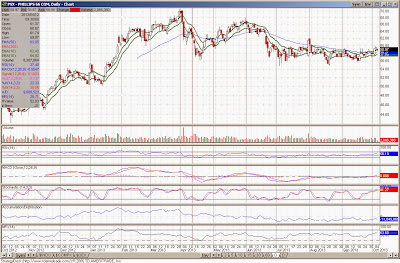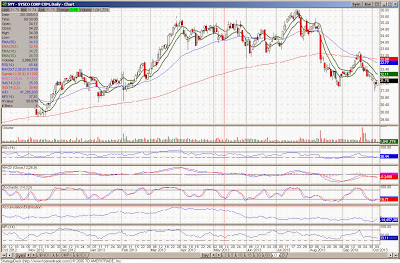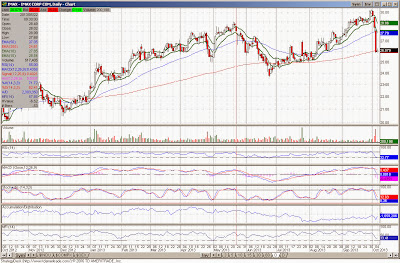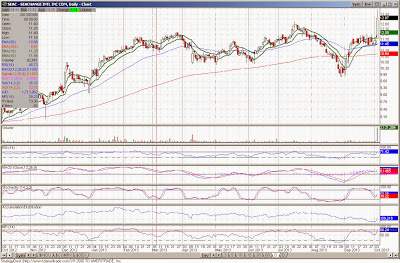Friday, October 4, 2013
Significant Analyst Recommendation Actions- 10/4/13
I am starting a new piece here highlighting what I will call significant analyst recommendation actions. This piece is based on the research I posted previously, which can be found here. Although I am likely to change the format and universe I sort through, all the while tweaking the criteria, I nonetheless wanted to take an initial stab at a compilation of names.
The way I will be defining 'significant analyst recommendation actions' will be two fold. First, positive actions will correspond with either ratings upgrades to buy or better in conjunction with an increase in the target price. Additionally, positive actions also include names with an increase in the target price that are already highly rated.
Inversely, negative actions correspond with rating downgrades to sell or worse that occurs in conjunction with a reduction in the target price. More so, the negative actions indicator will be tripped when a stock's recommendation is already negative weighted in conjunction with a large reduction in the target.
The universe I am drawing on currently is the S&P 1500. I intend to run this daily, at least for the time being.
Positive rating actions.
Negative rating actions
The way I will be defining 'significant analyst recommendation actions' will be two fold. First, positive actions will correspond with either ratings upgrades to buy or better in conjunction with an increase in the target price. Additionally, positive actions also include names with an increase in the target price that are already highly rated.
Inversely, negative actions correspond with rating downgrades to sell or worse that occurs in conjunction with a reduction in the target price. More so, the negative actions indicator will be tripped when a stock's recommendation is already negative weighted in conjunction with a large reduction in the target.
The universe I am drawing on currently is the S&P 1500. I intend to run this daily, at least for the time being.
Positive rating actions.
Negative rating actions
Guess What the Price/Volume Heat Map Indicates For 10/3 Trading Day
The equity market just cannot catch a bid. You can attribute this to whatever reason you wish (slow economy, debt ceiling debate anxieties, the government shutdown, etc.) but the fact is that supply is outweighing demand at the moment. When it will end is anyone's guess.
You could cover the screen below these comments and likely know what the price/volume heat map looks like. Supply far outweighed demand, as it has been sans one or two trading days for a week or two now. In fact, demand was almost nonexistent across all sectors. So far this morning, futures are indicating a positive open. We shall see if this optimism (?) carries through the rest of the day.
You could cover the screen below these comments and likely know what the price/volume heat map looks like. Supply far outweighed demand, as it has been sans one or two trading days for a week or two now. In fact, demand was almost nonexistent across all sectors. So far this morning, futures are indicating a positive open. We shall see if this optimism (?) carries through the rest of the day.
Thursday, October 3, 2013
Why Most Traders Fail
Was reading at the reformed broker a few days ago. Some really good advice for investors or traders.
What I like best about the Larry Benedict chapter in Jack Schwager's Hedge Fund Market Wizards book is that it opens with a story about repeated failure. Before becoming the uber-successful founder of Banyan Capital Management, Benedict failed and failed repeatedly but kept at it, using the proper discipline to assure that failed trades wouldn't knock him out of the game and never looking for a shortcut to make up for them.
Here he discusses why this is so important:
What I like best about the Larry Benedict chapter in Jack Schwager's Hedge Fund Market Wizards book is that it opens with a story about repeated failure. Before becoming the uber-successful founder of Banyan Capital Management, Benedict failed and failed repeatedly but kept at it, using the proper discipline to assure that failed trades wouldn't knock him out of the game and never looking for a shortcut to make up for them.
Here he discusses why this is so important:
Why do you think you have been successful whereas so many traders fail?
Since I started in the business, I have seen a number of traders who ended up committing suicide or being homeless. The one trait they all shared was that they had a gambler's mentality. When they were losing, they were always looking for that one trade that would make it all back. I learned early on that you can't do that. This is a business where you have to work. That's what I do. Every day I make hundreds of transactions. I grind out the returns. If you look at my daily returns, you will see there are very few big up days.
Keynesian Hatred of Savings
It still confounds me why Keynesians fail to understand that tool called financial predetermination exists and that one man's savings is another's investable funds. I find the rhetoric against savings as appalling and those who speak against it as naive.
By Gregory Bresiger at Mises.org
Our grandparents believed in the value of thrift, but many of their grandchildren don’t.
That’s because cultural and economic values have changed dramatically over the last generations as political and media elites have convinced many Americans that saving is passé. So today, under the influence of Keynesian economists who champion government spending and high levels of consumption, thrift has been devalued.
“The growth in wealth, so far from being dependent on the abstinence [savings] of the rich, as is commonly supposed, is more likely to be impeded by it,” according to John Maynard Keynes’s The General Theory of Employment, Interest and Money.
“The more virtuous we are, the more determinedly thrifty, the more obstinately orthodox in our national and personal finance, the more incomes will have to fall,” he writes. “Saving,” Keynes wrote in his Treatise on Money, “is the act of the individual consumer and consists in the negative act of refraining from spending the whole of his current income on consumption.”
But saving, pace Keynes, isn’t “negative.” It is deferred consumption. “The great producing countries are the great consuming countries,” writes Benjamin Anderson in Economics and the Public Welfare. More importantly, high rates of savings will lead to higher productivity, which would benefit our children and grandchildren, classical and Austrian economists have explained.
“We are the lucky heirs of our fathers and forefathers whose saving has accumulated the capital goods with the aid of which we are working today,” wrote Ludwig von Mises in Human Action. Saving, ultimately, is consumption, writes Detley S. Schlichter in Paper Money Collapse. “By setting aside some resources for meeting financial consumption needs, we invest them.”
Nevertheless, Keynesian ideas dominate the Obama administration and mass media. Most politicians, including Republicans who often pretend to be friends of thrift and self-improvement, are tacit or overt Keynesians. That’s because politicians, whether they have studied Keynes or not, generally love the idea of cheap money. Most delight in spending taxpayer dollars. They believe this is the way elections are won.
This Keynesian dominance has led to dramatic economic and cultural changes. These changes have been going on in America for over a half century. For instance, the United States has gone from a nation with one of the highest rates of savings during the 20s to having one of the lowest rates among major industrial nations today.
Yet penalizing thrift, the lifeblood of job creation and better tools that make current workers more efficient, has hurt the nation’s ability to grow and employ millions of young people looking for jobs. That’s because Keynesianism, according to its modern interpreters, amounts to a celebration of consumption. It is a belief that government spending combined with low savings rates lead to permanent booms.
It is the government’s role, Keynes’s followers believe, to keep the boom going through spending. So it is consumption, not supply, that makes a successful economy, they say.
Mainstream media rehashes the message that the consumer, not the producer, is the biggest part of the economy. Politicians agree.
As the economy started to slow down in 2006, President Bush urged Americans to “go shopping more.” Newsweek, in a headline story several years ago, told Americans to “Stop Saving Now.”
This anti-saving philosophy is more than just bad macro-economics. It is the doctrine that has come to take over economic thinking, now dominated in the popular media by Keynesian economists such as Paul Krugman. In his latest book, End This Depression Now, he explains why growth rates are low. The administration hasn’t been sufficiently Keynesian enough. Obama’s stimulus, he complains, was on a “wholly inadequate scale.”
Keynesians of all stripes have constantly urged Americans, especially the government, to spend. The effect of this change has been more than numbers. It also changed how many Americans see the path to self-improvement. Joe Sixpack, the average American who once believed that through thrift, hard work and discipline he could save his way to a better life for his family, is the victim. Keynesian economists and mainstream media commentators often depict savers as selfish people.
Even the average person with his savings account, living in a Brooklyn tenement (I’m speaking of bus driver Ralph Kramden from the iconic television series The Honeymooners) must pay taxes on his measly $75 savings account. This anti-savings mentality has amazed some from nations where savings are viewed positively.
A former U.S. Commerce Secretary was asked by his Japanese counterpart in the 1970s in Pete Peterson’s book Facing Up, “please explain putting the highest taxes on what you call unearned income. We have always assumed that income from savings was the most earned of all. It is hard work to save, don’t you think?”
Tens of millions of baby boomers aren’t doing the hard work. They have little or no savings. How will Keynes and his scions’ misguided policies provide a decent standard of living for them?
America’s personal savings rate declined some 56 percent over the past 50 years from 1963-2012, according to the 2013 Economic Report of the President. The personal savings rate averaged just 3.8 percent in the decade between 2003 and 2012. That’s a big drop compared to the 1963-1972 period when it was 8.7 percent.
However, it’s worse than that. Since the end of last year, the personal savings rate has declined some more, dipping to 2.5 percent in March and April, according to the U.S. Commerce Department’s Bureau of Economic Analysis.
Even President Obama’s economic report, in documenting that savings rates are low, concedes that the recovery that began some four years ago is weak. The recovery, according to the president’s report, trails previous ones.
“From 1960 to 2007, the U.S. economy had seven recessions, and the annual rate of growth of real GDP during the 12 quarters following these recessions was 4.2 percent,” the presidential report said. “In contrast, during the 12 quarters following the trough in the second quarter of 2009, the average annual rate of growth of real GDP was 2.2 percent. After three years of recovery, the cumulative growth of real GDP was 6.3 percentage points lower than the average value for the earlier post-1960 recessions.”
Meanwhile, savers are penalized for their thrift. The Fed’s policies mean they receive almost nothing in interest.
Remarkably, President Obama, in the same report, in a move Keynes would have likely applauded, proposes to put a cap on qualified retirement plan balances. Apparently, the president agrees saving is “a negative act.”
These anti-saving policies should change, some say. A better tax code, one that promotes and doesn’t tax savings to death, will “mean more innovation, job creation and higher wages,” U.S. House of Representatives Ways and Means Committee Chairman Dave Camp noted when I interviewed him for an article in the New York Post.
“When workers see paychecks start to rise again,” Camp adds, “they will be better able to make decisions that best serve the financial needs of their family — including building up their savings.”
But that doesn’t necessarily mean Camp and others will now reject Keynes. Plenty of Republicans— consciously or unconsciously — have shown themselves to be philosophical followers of Keynes. And Camp, working on an overhaul of the tax code, might consider a logical measure: Why not drop all taxes on a savings and investment as a way to reverse decades of destructive economic policy?
That could be the most important decision for a generation of young people without work because doesn’t generate enough capital. It could also be critical for their parents who approach a retirement with a falling standard of living.
Despite the Keynesian sentiments of much of our political and media elites, we owe it to our grandparents to re-learn the lessons of thrift.
By Gregory Bresiger at Mises.org
Our grandparents believed in the value of thrift, but many of their grandchildren don’t.
That’s because cultural and economic values have changed dramatically over the last generations as political and media elites have convinced many Americans that saving is passé. So today, under the influence of Keynesian economists who champion government spending and high levels of consumption, thrift has been devalued.
“The growth in wealth, so far from being dependent on the abstinence [savings] of the rich, as is commonly supposed, is more likely to be impeded by it,” according to John Maynard Keynes’s The General Theory of Employment, Interest and Money.
“The more virtuous we are, the more determinedly thrifty, the more obstinately orthodox in our national and personal finance, the more incomes will have to fall,” he writes. “Saving,” Keynes wrote in his Treatise on Money, “is the act of the individual consumer and consists in the negative act of refraining from spending the whole of his current income on consumption.”
But saving, pace Keynes, isn’t “negative.” It is deferred consumption. “The great producing countries are the great consuming countries,” writes Benjamin Anderson in Economics and the Public Welfare. More importantly, high rates of savings will lead to higher productivity, which would benefit our children and grandchildren, classical and Austrian economists have explained.
“We are the lucky heirs of our fathers and forefathers whose saving has accumulated the capital goods with the aid of which we are working today,” wrote Ludwig von Mises in Human Action. Saving, ultimately, is consumption, writes Detley S. Schlichter in Paper Money Collapse. “By setting aside some resources for meeting financial consumption needs, we invest them.”
Nevertheless, Keynesian ideas dominate the Obama administration and mass media. Most politicians, including Republicans who often pretend to be friends of thrift and self-improvement, are tacit or overt Keynesians. That’s because politicians, whether they have studied Keynes or not, generally love the idea of cheap money. Most delight in spending taxpayer dollars. They believe this is the way elections are won.
This Keynesian dominance has led to dramatic economic and cultural changes. These changes have been going on in America for over a half century. For instance, the United States has gone from a nation with one of the highest rates of savings during the 20s to having one of the lowest rates among major industrial nations today.
Yet penalizing thrift, the lifeblood of job creation and better tools that make current workers more efficient, has hurt the nation’s ability to grow and employ millions of young people looking for jobs. That’s because Keynesianism, according to its modern interpreters, amounts to a celebration of consumption. It is a belief that government spending combined with low savings rates lead to permanent booms.
It is the government’s role, Keynes’s followers believe, to keep the boom going through spending. So it is consumption, not supply, that makes a successful economy, they say.
Mainstream media rehashes the message that the consumer, not the producer, is the biggest part of the economy. Politicians agree.
As the economy started to slow down in 2006, President Bush urged Americans to “go shopping more.” Newsweek, in a headline story several years ago, told Americans to “Stop Saving Now.”
This anti-saving philosophy is more than just bad macro-economics. It is the doctrine that has come to take over economic thinking, now dominated in the popular media by Keynesian economists such as Paul Krugman. In his latest book, End This Depression Now, he explains why growth rates are low. The administration hasn’t been sufficiently Keynesian enough. Obama’s stimulus, he complains, was on a “wholly inadequate scale.”
Keynesians of all stripes have constantly urged Americans, especially the government, to spend. The effect of this change has been more than numbers. It also changed how many Americans see the path to self-improvement. Joe Sixpack, the average American who once believed that through thrift, hard work and discipline he could save his way to a better life for his family, is the victim. Keynesian economists and mainstream media commentators often depict savers as selfish people.
Even the average person with his savings account, living in a Brooklyn tenement (I’m speaking of bus driver Ralph Kramden from the iconic television series The Honeymooners) must pay taxes on his measly $75 savings account. This anti-savings mentality has amazed some from nations where savings are viewed positively.
A former U.S. Commerce Secretary was asked by his Japanese counterpart in the 1970s in Pete Peterson’s book Facing Up, “please explain putting the highest taxes on what you call unearned income. We have always assumed that income from savings was the most earned of all. It is hard work to save, don’t you think?”
Tens of millions of baby boomers aren’t doing the hard work. They have little or no savings. How will Keynes and his scions’ misguided policies provide a decent standard of living for them?
America’s personal savings rate declined some 56 percent over the past 50 years from 1963-2012, according to the 2013 Economic Report of the President. The personal savings rate averaged just 3.8 percent in the decade between 2003 and 2012. That’s a big drop compared to the 1963-1972 period when it was 8.7 percent.
However, it’s worse than that. Since the end of last year, the personal savings rate has declined some more, dipping to 2.5 percent in March and April, according to the U.S. Commerce Department’s Bureau of Economic Analysis.
Even President Obama’s economic report, in documenting that savings rates are low, concedes that the recovery that began some four years ago is weak. The recovery, according to the president’s report, trails previous ones.
“From 1960 to 2007, the U.S. economy had seven recessions, and the annual rate of growth of real GDP during the 12 quarters following these recessions was 4.2 percent,” the presidential report said. “In contrast, during the 12 quarters following the trough in the second quarter of 2009, the average annual rate of growth of real GDP was 2.2 percent. After three years of recovery, the cumulative growth of real GDP was 6.3 percentage points lower than the average value for the earlier post-1960 recessions.”
Meanwhile, savers are penalized for their thrift. The Fed’s policies mean they receive almost nothing in interest.
Remarkably, President Obama, in the same report, in a move Keynes would have likely applauded, proposes to put a cap on qualified retirement plan balances. Apparently, the president agrees saving is “a negative act.”
These anti-saving policies should change, some say. A better tax code, one that promotes and doesn’t tax savings to death, will “mean more innovation, job creation and higher wages,” U.S. House of Representatives Ways and Means Committee Chairman Dave Camp noted when I interviewed him for an article in the New York Post.
“When workers see paychecks start to rise again,” Camp adds, “they will be better able to make decisions that best serve the financial needs of their family — including building up their savings.”
But that doesn’t necessarily mean Camp and others will now reject Keynes. Plenty of Republicans— consciously or unconsciously — have shown themselves to be philosophical followers of Keynes. And Camp, working on an overhaul of the tax code, might consider a logical measure: Why not drop all taxes on a savings and investment as a way to reverse decades of destructive economic policy?
That could be the most important decision for a generation of young people without work because doesn’t generate enough capital. It could also be critical for their parents who approach a retirement with a falling standard of living.
Despite the Keynesian sentiments of much of our political and media elites, we owe it to our grandparents to re-learn the lessons of thrift.
Raw Video Of Capital Hill Shooting
In case you are unaware, there was a shooting on Capital Hill this afternoon after a crazed woman tried to run the barricade at the White House. The following is the raw footage of those events.
QE Will Ultimately Die- Bill Gross
As I have stated and have shown, once QE ends the market will tank despite whatever happens to interest rates.
Surging Stocks and Slumping Economy Duality To Continue For a While- Biderman
What have I been saying.... except for taking my lumps on ill-timed short positions.
Volume Off the High- 10/2 Trading Day Edition
The trend continues. A limited number of names coming off the highs versus new high volume highs in a weak overall market. My opinion is that this suggests that market sentiment remains towards the upside but other events (gov't shutdown and the looming debt ceiling talks) are pushing the market down overall. This is despite continuing to believe that the economy remains weak and growth is decelerating.
Subscribe to:
Comments (Atom)


















































